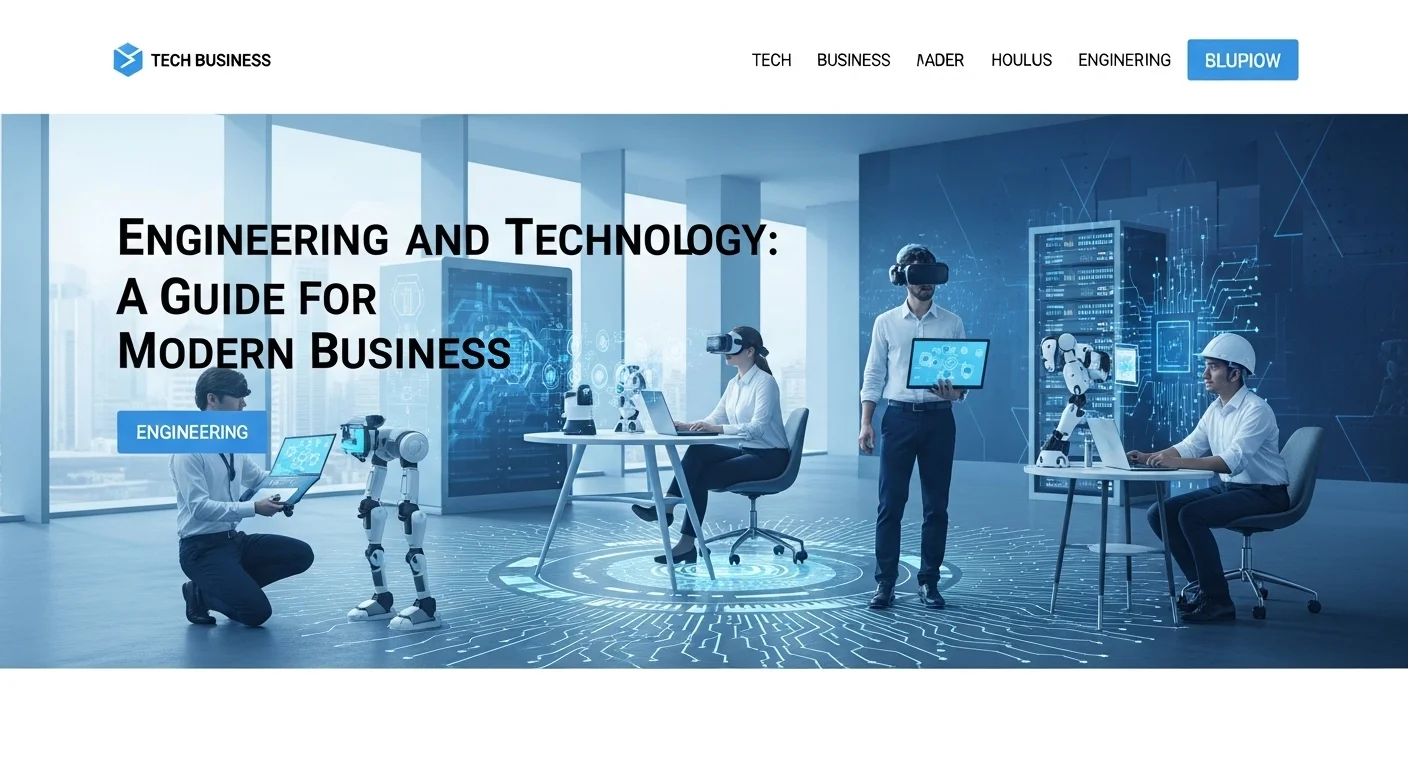Engineering and Technology: A Guide for Modern Business

Executive Summary
In the digital age, the convergence of engineering and technology is reshaping industries. This article explores the critical role of modern engineering disciplines in driving business success. We delve into how specialized fields such as Site Reliability Engineering (SRE) ensure that digital services are robust and always available, building customer trust. We examine the rise of the Platform Engineer, a crucial role for creating internal systems that accelerate software development and innovation. Furthermore, we break down Model-Based Systems Engineering (MBSE), a sophisticated approach to managing the complexity of large-scale technology projects, from AI systems to cloud infrastructure. [1, 2] The practical application of engineering principles, known as engineering technology, is also covered, highlighting how theoretical designs are transformed into tangible solutions. [17, 21] Finally, we look at the evolving role of the Manufacturing Engineer in both the hardware and software realms, demonstrating how engineering is the engine of technological progress and a cornerstone of modern business strategy. [16, 41] By understanding these interconnected disciplines, businesses can unlock new levels of efficiency, reliability, and innovation.
Table of Contents
What is Engineering and why is it important in Technology?
In the contemporary business landscape, the terms 'Engineering' and 'Technology' are often used interchangeably, yet they represent distinct but deeply interconnected domains that collectively form the backbone of modern innovation. Engineering, in its broadest sense, is the application of scientific and mathematical principles to design, build, and maintain structures, machines, systems, and processes. Technology, on the other hand, is the collection of techniques, skills, methods, and processes used in the production of goods or services or in the accomplishment of objectives. When these two forces merge, they create a powerful engine for progress, driving everything from the cloud computing services that power global enterprises to the artificial intelligence that is redefining entire industries. The importance of engineering in technology cannot be overstated; it is the discipline that provides the structure, reliability, and scalability required for technological concepts to become viable, real-world solutions. It transforms a brilliant idea into a functional, robust, and efficient product or system.
At the heart of this intersection lies engineering technology, a field that bridges the gap between theoretical engineering and practical application. [21, 34] While a theoretical engineer might design a new type of computer chip based on complex physics, it is the engineering technologist who works on the practical side of development, testing, and implementation. [17] They are the hands-on problem-solvers who ensure that designs are not just conceptually sound but also manufacturable, maintainable, and effective in their intended environment. [12] This practical focus is crucial in the fast-paced world of tech, where speed to market and reliability are paramount. Businesses rely on engineering technology professionals to translate innovative designs into tangible products, whether it's setting up a new server farm, deploying a complex software update, or calibrating the sensitive machinery used in electronics production.
The Pillars of Modern Tech Engineering
As technology has grown in complexity, engineering has specialized into several key disciplines that are now indispensable for any technology-driven business. These specializations address the unique challenges of building and operating digital systems at scale. Understanding these roles and methodologies is fundamental to appreciating how modern technology is built and sustained.
One of the most critical modern disciplines is Site Reliability Engineering (SRE). Coined by Google, SRE is an approach that treats operations and infrastructure management as a software engineering problem. [22, 26] Instead of a traditional operations team that manually manages servers and responds to incidents, an SRE team writes code to automate these tasks, making the entire system more scalable and reliable. [3, 7] SREs are responsible for the availability, latency, performance, and capacity of a service. They establish Service Level Objectives (SLOs)—specific, measurable targets for reliability—and use an 'error budget' to balance the need for new features with the need for stability. [3] If a service is more reliable than its SLO, the development team can release new features more quickly. If it falls below the SLO, the focus shifts to improving reliability. This data-driven approach is vital for businesses whose revenue depends on the constant availability of their digital services, such as e-commerce platforms, streaming services, and cloud-based software providers.
Another pivotal role that has emerged is that of the platform engineer. As software development has become more complex, with microservices, containers, and cloud-native architectures, developers can become overwhelmed by the cognitive load of managing the underlying infrastructure. [11] A platform engineer addresses this challenge by building and maintaining an Internal Developer Platform (IDP). [6, 18] An IDP is a set of standardized tools and automated workflows that abstracts away the complexities of infrastructure, security, and compliance. [30] It provides developers with 'golden paths'—pre-defined, optimized ways to build, test, and deploy their applications. [15] By offering self-service capabilities, platform engineering teams empower developers to deliver value faster and more efficiently, without needing to be experts in Kubernetes, cloud security, or network configuration. [11, 25] For businesses, this translates into accelerated innovation cycles, improved security posture, and greater consistency across all software projects. [27]
Designing and Manufacturing the Future
The complexity of modern systems, from autonomous vehicles to global telecommunication networks, requires a rigorous and holistic design approach. This is where model based systems engineering (MBSE) comes in. MBSE is a methodology that uses digital models as the central artifact of the system design process, rather than relying on traditional, document-centric approaches. [2, 4] These models provide a comprehensive, interconnected representation of the entire system, including its requirements, architecture, behavior, and the relationships between its components. [1] By creating a 'single source of truth', MBSE helps teams from different disciplines (mechanical, electrical, software) to collaborate more effectively and identify potential design flaws, inconsistencies, or integration issues early in the lifecycle. [10] This is particularly crucial for developing complex AI and cybersecurity systems, where the interactions between components are intricate and the consequences of failure are severe. For businesses, adopting MBSE reduces development risks, lowers costs by catching errors before physical prototypes are built, and accelerates the overall development timeline. [4, 5]
Finally, the role of the manufacturing engineer remains as crucial as ever, though its scope has expanded significantly in the technology sector. [41] In the traditional sense, a manufacturing engineer designs and optimizes the processes for producing physical goods. [16] In the tech world, this applies directly to the production of hardware, such as servers, smartphones, IoT devices, and semiconductors. They are responsible for ensuring that production lines are efficient, cost-effective, and produce high-quality products. [35] However, the principles of manufacturing engineering are now also being applied to software development. The concept of a 'software factory' uses automation and standardized processes, such as Continuous Integration and Continuous Deployment (CI/CD) pipelines, to 'manufacture' software in a predictable, reliable, and efficient manner. [20] In this context, a manufacturing engineer might be responsible for designing and optimizing these automated pipelines, ensuring that code can move from a developer's machine to production seamlessly and safely. This dual role in both hardware and software production highlights how fundamental engineering principles are to the entire technology value chain, ensuring that innovation can be delivered at scale.
In conclusion, engineering provides the essential framework that allows technology to flourish. From the hands-on implementation of engineering technology to the strategic oversight of site reliability engineering and platform engineer teams, and from the meticulous planning of model based systems engineering to the process optimization driven by a manufacturing engineer, these disciplines are not just technical functions; they are core business enablers. They ensure that technology is not only powerful and innovative but also reliable, scalable, and secure, forming the bedrock upon which successful modern enterprises are built.

Complete guide to Engineering in Technology and Business Solutions
A deep understanding of the various engineering disciplines within technology is essential for any business aiming to thrive in the digital economy. These disciplines offer a structured approach to solving complex problems, ensuring that technological solutions are not only innovative but also robust, scalable, and aligned with business objectives. This guide provides a comprehensive look at the technical methods, business techniques, and available resources related to key engineering roles and methodologies that are shaping the modern tech landscape.
Technical Methods and Business Techniques of Key Engineering Disciplines
Each specialized engineering field employs a unique set of tools and methodologies. Integrating these into a business strategy can yield significant competitive advantages, from enhanced reliability to accelerated product delivery.
Site Reliability Engineering (SRE)
Technical Methods: SRE operates on a foundation of data and automation. The core technical components include:
- Service Level Indicators (SLIs), Service Level Objectives (SLOs), and Service Level Agreements (SLAs): An SLI is a quantitative measure of some aspect of the service, like latency or availability. An SLO is a target value for an SLI over a period. [3] An SLA is a formal contract with users that includes consequences for failing to meet SLOs. SRE teams focus on SLOs as their internal guide for reliability. [7]
- Error Budgets: The error budget is the mathematical inverse of the SLO (e.g., an SLO of 99.9% availability means a 0.1% error budget). This budget represents the acceptable level of unreliability. [3] Development teams are free to use this budget for new releases; if the budget is exhausted by failures, all new development halts until reliability is restored.
- Automation: A core tenet of SRE is to eliminate 'toil'—manual, repetitive, automatable work that lacks long-term value. SREs write code to automate everything from incident response and capacity planning to infrastructure provisioning.
- Monitoring and Observability: SRE teams implement comprehensive monitoring systems to track SLIs and overall system health in real-time. This goes beyond simple alerts to 'observability,' which is the ability to ask arbitrary questions about the system's state without having to pre-define all metrics.
Business Techniques: SRE directly impacts business outcomes by:
- Aligning Reliability with Business Goals: By co-defining SLOs with product managers, SRE ensures that the level of reliability for a service is appropriate for its business function. Not every service needs 99.999% uptime; a less critical internal tool might have a more lenient SLO, saving engineering resources.
- Data-Driven Decision Making: Error budgets provide a clear, objective framework for balancing innovation speed with stability. This eliminates emotional debates between development ('move faster') and operations ('stay stable') teams. [26]
- Improving Customer Trust: Consistently meeting or exceeding reliability targets builds immense customer trust and loyalty, which is a significant competitive differentiator.
Platform Engineering
Technical Methods: The primary output of a platform engineer is the Internal Developer Platform (IDP), built using a variety of technologies:
- Infrastructure as Code (IaC): Tools like Terraform, Ansible, and Pulumi are used to define and manage infrastructure through code, enabling automated, repeatable, and version-controlled environment provisioning. [30, 39]
- Containerization and Orchestration: Docker and Kubernetes are the de facto standards. Platform engineers build and maintain a secure, multi-tenant Kubernetes platform that developers can use to deploy their applications without needing deep expertise in container orchestration.
- CI/CD Pipelines: The IDP provides standardized, reusable CI/CD pipeline templates (e.g., using Jenkins, GitLab CI, or GitHub Actions) that handle building, testing, security scanning, and deploying applications.
- Self-Service Portals: Often, a central web interface (like Backstage or a custom-built portal) is created to serve as the single pane of glass for developers. Through this portal, they can scaffold new services, provision resources, view monitoring dashboards, and access documentation. [18]
Business Techniques: Platform engineering delivers business value by:
- Accelerating Time to Market: By reducing the cognitive load on developers and automating common tasks, platform engineering drastically shortens the time from idea to production. [15, 27]
- Improving Developer Experience (DevEx) and Retention: A smooth, efficient platform makes developers happier and more productive, which is a key factor in attracting and retaining top talent. [25, 27]
- Enforcing Governance and Security: The platform can have security policies, compliance checks, and cost controls built-in, ensuring that all development teams adhere to organizational standards without slowing them down. [13, 33]
Designing for Complexity and Production
Model-Based Systems Engineering (MBSE)
Technical Methods: MBSE relies on standardized modeling languages and sophisticated software tools.
- Modeling Languages: The Systems Modeling Language (SysML) is the most common language used in MBSE. It is a graphical language that provides a set of diagrams for specifying system requirements, structure, behavior, and constraints. [1, 44] UML (Unified Modeling Language) is also used, particularly for software-intensive systems. [44]
- MBSE Tools: Software like Cameo Systems Modeler, PTC Windchill Modeler, and Sparx Systems Enterprise Architect provide the environment for creating and managing these models. [9] These tools enable collaboration, version control, and integration with other engineering software (e.g., simulation or analysis tools). [38]
- Digital Thread: A key concept in MBSE is the 'digital thread,' which creates a connected, traceable link between all elements of the system model, from initial requirements to final verification and validation. [10] This ensures that any change is propagated and its impact assessed across the entire system.
Business Techniques: MBSE offers profound business benefits, especially for organizations building complex, high-stakes products.
- Early-Stage Risk Reduction: By simulating and analyzing the system model, engineers can detect design flaws and integration issues long before committing to expensive hardware or software development. [2]
- Enhanced Communication and Collaboration: The visual model serves as a common language that all stakeholders—from engineers to project managers to customers—can understand, reducing misunderstandings and aligning everyone on the system's design and objectives. [4]
- Improved Requirements Management: MBSE ensures that all system requirements are captured, analyzed, and traced throughout the design process, preventing 'requirements creep' and ensuring the final product meets its intended purpose. [5]
Manufacturing Engineer in the Tech Sphere
Technical Methods: The modern manufacturing engineer in technology utilizes a blend of traditional and digital techniques.
- Hardware Production: This involves process design, quality control (e.g., Six Sigma, statistical process control), and automation using robotics and computer-aided manufacturing (CAM) systems. They work on optimizing assembly lines for everything from servers to IoT sensors. [12, 35]
- Software 'Manufacturing' (CI/CD): Here, the methods involve designing robust, automated software delivery pipelines. This includes version control strategies (e.g., GitFlow), automated testing frameworks (unit, integration, end-to-end), and deployment strategies (e.g., blue-green, canary).
- Mechatronics and IoT: For physical products, manufacturing engineers are increasingly working with mechatronics—the integration of mechanical, electrical, and computer engineering—to create smart, connected devices. [20]
Business Techniques: The role is focused on efficiency, quality, and cost-effectiveness.
- Lean Manufacturing Principles: Applying concepts like waste reduction and continuous improvement to both hardware and software production processes to maximize value and minimize cost. [20]
- Supply Chain Optimization: In hardware, this involves working with suppliers and logistics to ensure a resilient and cost-effective supply chain. In software, it can mean managing dependencies on open-source libraries and third-party APIs.
- Scalability and Efficiency: Whether for a factory floor or a software pipeline, the goal is to design a process that can scale to meet demand without a proportional increase in cost or decrease in quality. [41]
The Role of Engineering Technology
The field of engineering technology is less about a single methodology and more about a practical mindset. Professionals in this area use a variety of tools, from computer-aided design (CAD) software to network analyzers and testing equipment, to implement and validate the designs created by engineers. [17, 23] Their business value lies in being the crucial link that ensures theoretical plans are executed correctly, efficiently, and safely in the real world, providing essential feedback to designers about what is practical and achievable. [34] Without skilled engineering technologists, even the most brilliant engineering concepts would remain on the drawing board.

Tips and strategies for Engineering to improve your Technology experience
Embracing a robust engineering culture is not merely about hiring technical staff; it's about embedding principles of discipline, quality, and continuous improvement into the very fabric of a business. For companies looking to leverage technology as a strategic asset, adopting the best practices from various engineering disciplines is paramount. This section offers practical tips, strategies, and insights into the tools and future trends that can enhance your organization's technological capabilities and drive a superior business experience.
Best Practices for Implementing Engineering Methodologies
Successfully integrating advanced engineering practices requires a strategic and cultural shift. Here are best practices for some of the key disciplines:
Implementing Site Reliability Engineering (SRE)
- Start Small and Define Clear SLOs: Don't try to implement SRE across the entire organization at once. Begin with a single, critical service. Work with business stakeholders to define meaningful Service Level Objectives (SLOs) that reflect user happiness. [7] This initial success will build momentum and provide a blueprint for expansion.
- Empower the SRE Team: An SRE team must have the authority to enforce the error budget. If the budget is spent, they must be empowered to halt new feature releases and direct development efforts toward stabilization. This requires strong executive support. [3]
- Foster a Culture of Blameless Postmortems: When an incident occurs, the goal is not to find who to blame, but to understand the systemic causes. A blameless postmortem process encourages honesty and focuses on creating action items to prevent the issue from recurring. This builds a culture of psychological safety and learning.
- Automate Everything Possible: The mantra of SRE is to eliminate toil. Invest in automation for deployment, testing, incident response, and capacity planning. This frees up engineers to focus on high-value work that improves long-term reliability. [26]
Building an Effective Platform Engineering Team
- Treat Your Platform as a Product: The platform engineer team should have a product manager. They need to understand their customers (the developers), gather requirements, create a roadmap, and market their platform internally. [6] The goal is to build a platform developers *want* to use, not one they are forced to use.
- Focus on Developer Experience (DevEx): The primary goal of an Internal Developer Platform (IDP) is to reduce cognitive load and streamline workflows. [11, 27] Constantly solicit feedback from developers. Is the documentation clear? Are the tools intuitive? Is the 'golden path' truly the easiest path? [15]
- Start with a 'Thin Viable Platform' (TVP): Avoid the temptation to build a massive, all-encompassing platform from day one. Identify the most significant pain point in the development lifecycle and build a solution for that first. Iterate and expand the platform based on real user needs.
- Provide Paved Roads, Not Walled Gardens: While the platform should offer standardized 'golden paths', it should also provide flexibility for teams with unique requirements. The goal is to make the standard way the easy way, but not the only way. This prevents teams from abandoning the platform when they hit a roadblock.
Tools of the Trade for Modern Engineering
Equipping your teams with the right tools is essential for success. The technology landscape is vast, but certain tools have become industry standards across these disciplines.
- For Site Reliability Engineering:
- Monitoring & Observability: Prometheus (for metrics), Grafana (for visualization), Jaeger/Zipkin (for tracing), and the ELK Stack (Elasticsearch, Logstash, Kibana) for logging.
- Incident Management: PagerDuty, Opsgenie for alerting and on-call scheduling.
- Automation: Ansible, Puppet, or custom scripts for configuration management and automated responses. - For Platform Engineering:
- Infrastructure as Code (IaC): Terraform is the dominant player for provisioning cloud infrastructure. [30]
- Container Orchestration: Kubernetes is the undisputed leader. Cloud providers offer managed versions like EKS (Amazon), GKE (Google), and AKS (Azure).
- CI/CD: GitLab CI, GitHub Actions, Jenkins, and CircleCI are all powerful options for building automated pipelines.
- IDP Portals: Spotify's open-source Backstage.io has become a popular foundation for building developer portals. - For Model-Based Systems Engineering (MBSE):
- Modeling Software: Dassault Systèmes' CATIA Magic (formerly Cameo), PTC Windchill Modeler, and Sparx Systems Enterprise Architect are comprehensive tools for SysML modeling. [9, 44]
- Simulation & Analysis: MATLAB/Simulink and Ansys tools are often integrated with MBSE platforms to perform dynamic analysis and simulation of the system models. [1, 10]
Future Trends and the Evolution of Engineering Roles
The field of engineering is in a constant state of evolution, driven by advancements in technology. Staying ahead of these trends is crucial for long-term business success.
- The Rise of AI in Engineering: Artificial intelligence is set to revolutionize every engineering discipline. In SRE, AIOps platforms are emerging to predict failures before they happen and automate complex root cause analysis. For the manufacturing engineer, AI is driving generative design, where algorithms propose thousands of design variations based on a set of constraints, and powering predictive maintenance on factory floors. [8, 14, 24] In model based systems engineering, AI will help manage even greater complexity and potentially automate parts of the system design process itself. [31]
- The Convergence of SRE and Platform Engineering: The lines between these two roles are blurring. Platform engineering provides the reliable, automated foundation, while SRE ensures that the platform and the services running on it meet their reliability targets. Many organizations are combining these functions into a single 'Platform and Reliability' team to create a holistic approach to building and operating software. [15, 33]
- Digital Twins: A direct outcome of advanced model based systems engineering, a digital twin is a dynamic, virtual representation of a physical object or system. [1] A manufacturing engineer can use a digital twin of a factory to simulate process changes and optimize production without disrupting the real-world facility. SREs can use digital twins of their infrastructure to test failure scenarios and validate recovery plans.
- The Importance of 'Soft Skills': As engineering becomes more collaborative and product-focused, non-technical skills are becoming just as important as technical expertise. Communication, collaboration, empathy for the user, and a strong business acumen are essential for a modern platform engineer, SRE, or any technologist who wants to have a significant impact.
In conclusion, building a world-class technology organization is a journey of continuous improvement. By adopting the best practices of disciplines like site reliability engineering and platform engineering, investing in modern tools, and keeping an eye on future trends, businesses can create a powerful engine for innovation. The practical application of engineering technology, the systematic approach of MBSE, and the efficiency focus of the manufacturing engineer all contribute to a culture where technology is not just a cost center, but a strategic driver of value, reliability, and unparalleled customer experience. For further reading, an excellent resource on the principles of building scalable and reliable systems is the original Google SRE book, available online.
Expert Reviews & Testimonials
Sarah Johnson, Business Owner ⭐⭐⭐
The information about Engineering is correct but I think they could add more practical examples for business owners like us.
Mike Chen, IT Consultant ⭐⭐⭐⭐
Useful article about Engineering. It helped me better understand the topic, although some concepts could be explained more simply.
Emma Davis, Tech Expert ⭐⭐⭐⭐⭐
Excellent article! Very comprehensive on Engineering. It helped me a lot for my specialization and I understood everything perfectly.



